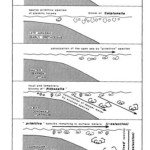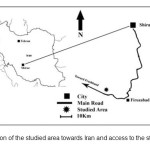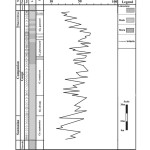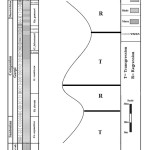The Determination of Paleodepth Changes in the Sedimentary Basins, Using Gurpiʼs Formation Planktonic Foraminifers Morphotypes in the Bachun Stratigraphic Section (West Of Firuzabad, Iran)
Iman Bardestani Nejad1 and Mohammad Reza Esmaeilbeig1 *
1
Department of Geology,
Islamic Azad University,
Shiraz,
Iran
DOI: http://dx.doi.org/10.12944/CWE.10.Special-Issue1.91
The determination of paleodepth and even its changes can have many applications in study the depositional environment and also the factors that depend on the water depth. Due to the abundance of foraminifers, especially planktonic foraminifera in the Gurpi Formation, one of the best ways to determine the changes in paleodepth is the investigation of planktonic foraminifera morphotypes abundance. By the investigation of the existing foraminifera morphotypes in the studied samples of the Gurpi Formation (Santonian - Maastrichtian) in the Bachun stratigraphic section (West of Firuzabad), an increase in the depth of water in Campanian and a decrease in depth of water in Maastrichtian is observed.
Copy the following to cite this article:
Bardestani-Nejad I, Esmaeilbeig M. R. The Determination of Paleodepth Changes in the Sedimentary Basins, Using Gurpiʼs Formation Planktonic Foraminifers Morphotypes in the Bachun Stratigraphic Section (West Of Firuzabad, Iran). Special Issue of Curr World Environ 2015;10(Special Issue May 2015). DOI:http://dx.doi.org/10.12944/CWE.10.Special-Issue1.91
Copy the following to cite this URL:
Bardestani-Nejad I, Esmaeilbeig M. R. The Determination of Paleodepth Changes in the Sedimentary Basins, Using Gurpiʼs Formation Planktonic Foraminifers Morphotypes in the Bachun Stratigraphic Section (West Of Firuzabad, Iran). Special Issue of Curr World Environ 2015;10(Special Issue May 2015). Available from: http://www.cwejournal.org?p=678/
Download article (pdf)
Citation Manager
Publish History
Select type of program for download
| Endnote EndNote format (Mac & Win) | |
| Reference Manager Ris format (Win only) | |
| Procite Ris format (Win only) | |
| Medlars Format | |
| RefWorks Format RefWorks format (Mac & Win) | |
| BibTex Format BibTex format (Mac & Win) |
Article Publishing History
| Received: | 2015-03-15 |
|---|---|
| Accepted: | 2015-03-26 |
Introduction
The determination of paleodepth and even its changes can have many applications in study the depositional environment and also the factors that depend on the water depth (e.g. quantity of elements). Generally, the determination of changes in paleodepth provides an overview of the progression and regression of sedimentary basin during the deposition of considered layers which will be utilized in lithostratigraphy, biostratigraphy and chemo stratigraphy. There are different ways to determine the paleodepth. One of the best ways is the investigation of planktonic foraminifera morphotypes abundance.Various studies have been done about the life of foraminifera which have been eventuated in the identification of the factors that influence foraminiferal assemblages on the water column. Among these, we can take the factors such as food supply, surface water currents, salinity, oxygen, light penetration , water density and water circulation into account. One of the key factors involved in this matter is water depth.Be (1982(, Hemleben and Spindler (1983), Hemleben et al. (1989), Arnold and Parker (1999), believed that modern foraminifera, based on their habitat depth, divide into two groups: The first group has spineous forms that live near the water surface and the second group is without spines that live in areas with greater depth. According to Murray (1976), with the increased depth, the planktonic foraminifera:benthic foraminifera ratio increased as well.Related to Cretaceous Period, many researchers have done different researches on various morphotypes subject among whom Hart and Baily (1979), Hart (1980), Caron and Homewood (1982), Hart(1999) include. Westermann et al.,(2010) studied about Tethys basin planktic foraminifera morphotypes. The abstract of these works demonstrate that globular shape forms live in more shallow and keeled forms live in deeper waters.Hart(1980a) studied the proportions of benthic foraminifera to planktons and the relationship between this proportion to the basin's depth. In another research, Hart(1980b) , for the first time, argued about the relationship between the evolution of planktonic foraminifera with the depth of sedimentary basin. Furthermore, other researchers like Caron and Homewood (1982), Caron (1983), Hart (1999), by the publication of their work, acknowledged a relationship between the apparent evolution and depth of the sedimentary basin. Hart (1999) believed that the evolution of planktonic foraminifera shells in Late Cretaceous is due to the increase in depth of sedimentary basins in world scale. In fact, these researches believed that with the rise of the sea level in Late Cretaceous, planktonic foraminifera shells move towards the complex shape of the shells and changing from globular to keeled shapes (Fig 1).
 |
Figure 1: Phases of colonization of the open sea by Mesozoic planktic foraminifers (Caron & homewood, 1983) Click here to View figure |
According to these studied models for the development of planktonic foraminifera, based on depth, Hart (1983b), Caron(1983), and Hart(1999) have done some researches. Accordingly, based on the various forms of planktonic foraminifera, we can determine three different morphotypes :
A. Morphotype Type 1 or Fauna of Shallow waters (0 to 50 m)The species of this group have a direct or trochospiral test with spherical chambers, without karren and with low ornamentation which include Heterohelix sp., Globogerinelloides sp., Hedbergella sp., and Pseudotextularia sp.
B. Morphotype Type 2 or Intermediate Fauna (50 to 100 m)The examples of this morphotype have the trochospiral test, compact chambers and primary karrens which include Preglobotruncana sp., Whitenella sp., Rugoglobigerina sp., and Archeoglobigerina sp.
C. Morphotype Type 3 or Fauna of Deep Waters ( more than 100 m )The examples of this group have trochospiral test with compact chambers and karren which include Rotalipora sp., Marginotruncana sp., Globotruncana sp., Gansserina sp., Dicarinella sp., and Globotruncanita sp. Among the mentioned examples, the plano-convex shapes are the indication of greater depths.
Research Method
Bachun stratigraphic section is located at 28 kilometers off northwest of Firuzabad. This city is situated in southwest of Fars Province and 90 kilometers off south of Shiraz (Fig. 2). Biostratigraphy studies of this section have been performed by Bardestani- Nejad (Bardestani- Nejad, 2014) which resulted in presentation of 8 biozones for Gurpi Formation in this Section.
According to the previous section and abundance of planktonic foraminifers in Gurpi Formation, using planktonic foraminifers morphotypes for determining depth of sedimentary basin of the Gurpi Formation is an appropriate method. For this purpose, various morphotypes in each thin section were counted and the ratio of morphotypes 1 and 2 (related to waters) to morphotype 3 (related to deeper areas) was determined as a percentage. This percentage has been obtained through the following equation.

In this equation, %M is the percentage of ratio percentage of morphotype 3 to morphotypes 1 and 2, M3 is the number of morphotype 3, M1 is the number of morphotype 1, and M2 is the number of morphotype 2.
According to the amount of M% in the samples of Gurpi Formation in the studied section, a diagram (Fig. 3) was drawn, showing the depth changes over the time. Also, a simplified diagram (Fig. 4) was drawn for changes of morphotypes percentage in which the process of transgression and regression of the basin can be observed. Accordingly, there are a depth rise at the beginning of the Santonain, then a regression at the beginning of the Campanian, and again a transgression which lasts up to the end of the Campanian, and finally a depth decrease starting near the end of the Campanian and the depth of the basin reaches to its lowest level in the late Maastrichtian (the last layers of Gurpi Formation). Considering unconformable contact between Gourpi and Pabdeh(its overlying formation) Formation (Bardestani Nejad, 2014), this depth decrease can be lead to an emergence from water at the end of the Maastrichtian.
 |
Figure 2: Situation of the studied area towards Iran and access to the studied section Click here to View figure |
 |
Figure 3: percentage of morphotype 3 to morphotypes 1 and 2 in the studied area Click here to View figure |
 |
Figure 4: diagram of changes of sedimentary basin of the studied area Click here to View figure |
Conclusion
Considering the shape of planktonic foraminifers tests and dividing them into three morphotypes, and study of percentage change of morphotype 3 to the sum of morphotypes 1 and 2, relative changes of depth of sedimentary basin can be determined. Accordingly, through performing studies on planktonic foraminifers morphotypes of Gurpi Formation in Bachun stratigraphic section, a general view of changes of depth of sedimentary basin of this Formation was obtained. The result of this study shows a depth incressing in the basin, immediately after the start of sedimentation of Gurpi Formation. The depth of Gurpi Formation basin declines in early Campanian and this decline changes to a depth incressing at the beginning of the middle Campanian. The process of basin depth regression starts near the end of the Campanian and continues to the end of Gurpi Formation. Considering unconformable contact of Gurpi with its overlying formation (Pabdeh Formation), basin regression in the Maastrichtian can be known as the leading to the basin emergence from water in the late Maastrichtian.
References
- Arnold A. J., Parker W. C., (1999), Biogeography osalam of planktonic foraminifra. In: Sen Gupta, B.K. (Ed.), Modern foraminifera. Kluwer, Dordrecht,pp. 103-122.
- Bardestani-Nejad I., 2014, Biostratigraphy and chemostratigraphy of the Gurpi Formation in Bachun stratigraphic section (west of Firoozabad – Fars Province), M.Sc. Thesis, Islamic Azad university Shiraz branch, Shiraz, Iran (in persian)
- Be A. W. H., (1982), Biology of planktonic foraminifera . in: Broadhead, T. H. (Ed.), foraminifera: Notes for a short course. Univ. Tehnessee Stud. Geol. 6,pp.
- Caron M., (1983), La speciation chez les foraminifers planctiques: Une reponse adaptee aux contriantes de l’environement. Zitteliana 10, 671-676.
- Caron M., Homewood P., (1982), Evolution of early planktic foraminifers, Mar. Micropaleontology, 7, 453-462.
- Hart M. B., (1999), The evolution and biodiversity of cretaceous planktonik foraminiferida. Geobios 32, 247-255.
- Hart M.B., (1980)(b), The recognition of mid-cretaceous se-level changes by means of foraminifera. Cretaceous Research1, 289-297.
- Hart M.B., 1980(a), A water depth model for the evolution of the planktonic foraminifera, Nature, Vol. 286, 252-254.
- Hart M.B., Baily H.W., (1979), The distribution of planktonic foraminifera in the mid-cretaceous of NW Europe. In : Wiedmann, J. (Ed), Aspecte der kreide Europas. Int. Union Geplogy Sci., Ser. A, 6, pp. 527-542
- Hemleben, C., Spindler, M. and Erson, O. R. (1989): Modern planktonic foraminifera, Springer, Berlin, 363 p.
- Hemleben, C., & Spindler, M., (1983). Recent advances in research on living planktonic foraminifera. Utrecht Micropaleontol. Bull, 30, 141-170.
- Murray W.,(1976), A method of determining proximity of marginal seas to an ocean, Marine Geology 22, 103-119.
- Westermann S., Caron M., Fiet N., Fleitmann D., Matera V., Adatte T., Föllmi K.B., (2010), Evidence for oxic conditions during oceanic anoxic event 2 in the northern Tethyan pelagic realm, Cretaceous Research, Volume 31, Issue 5, Pages 500-514.






